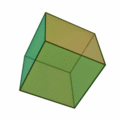In mathematics
A six-sided polygon is a hexagon, [1] one of the three regular polygons capable of tiling the plane. A hexagon also has 6 edges as well as 6 internal and external angles.
6 is the second smallest composite number. [1] It is also the first number that is the sum of its proper divisors, making it the smallest perfect number. [2] It is also the only perfect number that doesn't have a digital root of 1. [3] 6 is the first unitary perfect number, since it is the sum of its positive proper unitary divisors, without including itself. Only five such numbers are known to exist. [4] 6 is the largest of the four all-Harshad numbers. [5]
6 is the 2nd superior highly composite number, [6] the 2nd colossally abundant number, [7] the 3rd triangular number, [8] the 4th highly composite number, [9] a pronic number, [10] a congruent number, [11] a harmonic divisor number, [12] and a semiprime. [13] 6 is also the first Granville number, or -perfect number. A Golomb ruler of length 6 is a "perfect ruler". [14]
The six exponentials theorem guarantees that under certain conditions one of a set of six exponentials is transcendental. [15] The smallest non-abelian group is the symmetric group which has 3! = 6 elements. [1] 6 the answer to the two-dimensional kissing number problem. [16]

A cube has 6 faces. A tetrahedron has 6 edges. In four dimensions, there are a total of six convex regular polytopes.
In the classification of finite simple groups, twenty of twenty-six sporadic groups in the happy family are part of three families of groups which divide the order of the friendly giant, the largest sporadic group: five first generation Mathieu groups, seven second generation subquotients of the Leech lattice, and eight third generation subgroups of the friendly giant. The remaining six sporadic groups do not divide the order of the friendly giant, which are termed the pariahs (Ly, O'N, Ru, J4, J3, and J1). [17]
6 is the smallest integer which is not an exponent of a prime number, making it the smallest integer greater than 1 for which there does not exist a finite field of that size. [18]
List of basic calculations
| Multiplication | 1 | 2 | 3 | 4 | 5 | 6 | 7 | 8 | 9 | 10 | 11 | 12 | 13 | 14 | 15 | 16 | 17 | 18 | 19 | 20 | 25 | 50 | 100 | 1000 |
|---|---|---|---|---|---|---|---|---|---|---|---|---|---|---|---|---|---|---|---|---|---|---|---|---|
| 6 × x | 6 | 12 | 18 | 24 | 30 | 36 | 42 | 48 | 54 | 60 | 66 | 72 | 78 | 84 | 90 | 96 | 102 | 108 | 114 | 120 | 150 | 300 | 600 | 6000 |
| Division | 1 | 2 | 3 | 4 | 5 | 6 | 7 | 8 | 9 | 10 | 11 | 12 | 13 | 14 | 15 | |
|---|---|---|---|---|---|---|---|---|---|---|---|---|---|---|---|---|
| 6 ÷ x | 6 | 3 | 2 | 1.5 | 1.2 | 1 | 0.857142 | 0.75 | 0.6 | 0.6 | 0.54 | 0.5 | 0.461538 | 0.428571 | 0.4 | |
| x ÷ 6 | 0.16 | 0.3 | 0.5 | 0.6 | 0.83 | 1 | 1.16 | 1.3 | 1.5 | 1.6 | 1.83 | 2 | 2.16 | 2.3 | 2.5 |
| Exponentiation | 1 | 2 | 3 | 4 | 5 | 6 | 7 | 8 | 9 | 10 | 11 | 12 | 13 | |
|---|---|---|---|---|---|---|---|---|---|---|---|---|---|---|
| 6x | 6 | 36 | 216 | 1296 | 7776 | 46656 | 279936 | 1679616 | 10077696 | 60466176 | 362797056 | 2176782336 | 13060694016 | |
| x6 | 1 | 64 | 729 | 4096 | 15625 | 46656 | 117649 | 262144 | 531441 | 1000000 | 1771561 | 2985984 | 4826809 |




